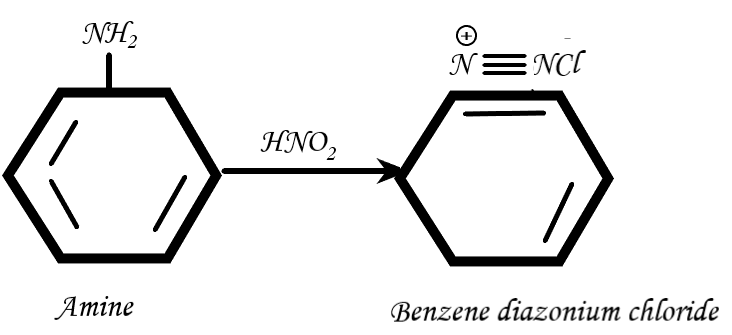
Aromatic primary amine when treated with cold \[HN{O_2}\] gives
(A) Benzyl Alcohol
(B) Nitro Benzene
(C) Benzene
(D) Diazonium salt
Answer
221.4k+ views
Hint: An amine is often a functional group with a lone pair on the nitrogen atom. Amines structurally mimic ammonia, where nitrogen can link with up to three hydrogen atoms. It is also defined by a number of carbon connectivity-based features.
Complete Step by Step Solution:
In order to know that when an alkyl or aryl group replaces one of the hydrogen atoms in the ammonia molecule, the presence of the primary amines can be determined. For instance: Methylamine \[{\text{ }}C{H_3}N{H_2}\]and Aniline \[{C_6}{H_5}N{H_2}\].
For the simple removal of a water molecule, nitrous acid \[(HN{O_2})\] is represented by the formula \[HO - N = O\]. As a result, a water molecule is created when the secondary amine's hydrogen ion joins with nitrous acid's \[O{H^ - }\]ion.
The reaction process that occurs when amine reacts with cold \[HN{O_2}\] will now be discussed below:
Using nitrous acid \[(HN{O_2})\]reagent to convert amine to diazonium ion,

A primary aromatic amines react with cold \[HN{O_2}\]and dissolved in dilute \[HCl\]at \[0 - 5^\circ C\]will produced diazonium salt. The nitrogen gas will emerge when the cold salt is heated to the room temperature.

Therefore, the correct option is: (D) Diazonium salt.
Note: It is important to remember that the carbylamine reaction is utilised to find primary amines. Isocyanide, a substance that is produced and has a strong odour, is the end result. This reaction is not produced by secondary or tertiary amines. The reaction is as following: \[RN{H_2} + CHC{l_3} + 3KOH \to RNC + 3KCl + 3{H_2}O\]
Complete Step by Step Solution:
In order to know that when an alkyl or aryl group replaces one of the hydrogen atoms in the ammonia molecule, the presence of the primary amines can be determined. For instance: Methylamine \[{\text{ }}C{H_3}N{H_2}\]and Aniline \[{C_6}{H_5}N{H_2}\].
For the simple removal of a water molecule, nitrous acid \[(HN{O_2})\] is represented by the formula \[HO - N = O\]. As a result, a water molecule is created when the secondary amine's hydrogen ion joins with nitrous acid's \[O{H^ - }\]ion.
The reaction process that occurs when amine reacts with cold \[HN{O_2}\] will now be discussed below:
Using nitrous acid \[(HN{O_2})\]reagent to convert amine to diazonium ion,

A primary aromatic amines react with cold \[HN{O_2}\]and dissolved in dilute \[HCl\]at \[0 - 5^\circ C\]will produced diazonium salt. The nitrogen gas will emerge when the cold salt is heated to the room temperature.

Therefore, the correct option is: (D) Diazonium salt.
Note: It is important to remember that the carbylamine reaction is utilised to find primary amines. Isocyanide, a substance that is produced and has a strong odour, is the end result. This reaction is not produced by secondary or tertiary amines. The reaction is as following: \[RN{H_2} + CHC{l_3} + 3KOH \to RNC + 3KCl + 3{H_2}O\]
Recently Updated Pages
Types of Solutions in Chemistry: Explained Simply

States of Matter Chapter For JEE Main Chemistry

Difference Between Alcohol and Phenol: Structure, Tests & Uses

Conduction Explained: Definition, Examples & Science for Students

Balancing of Redox Reactions - Important Concepts and Tips for JEE

Atomic Size - Important Concepts and Tips for JEE

Trending doubts
JEE Main 2026: Application Form Open, Exam Dates, Syllabus, Eligibility & Question Papers

Derivation of Equation of Trajectory Explained for Students

Hybridisation in Chemistry – Concept, Types & Applications

Understanding the Angle of Deviation in a Prism

How to Convert a Galvanometer into an Ammeter or Voltmeter

Degree of Dissociation: Meaning, Formula, Calculation & Uses

Other Pages
Solutions Class 12 Chemistry Chapter 1 CBSE Notes - 2025-26

NCERT Solutions For Class 12 Chemistry Chapter 1 Solutions - 2025-26

The D and F Block Elements Class 12 Chemistry Chapter 4 CBSE Notes - 2025-26

NCERT Solutions for Class 12 Chemistry Chapter Chapter 7 Alcohol Phenol and Ether

NCERT Solutions ForClass 12 Chemistry Chapter Chapter 8 Aldehydes Ketones And Carboxylic Acids

JEE Advanced Marks vs Ranks 2025: Understanding Category-wise Qualifying Marks and Previous Year Cut-offs




